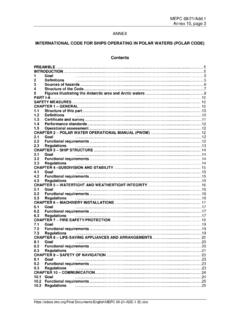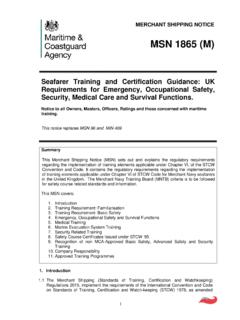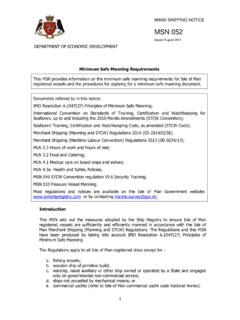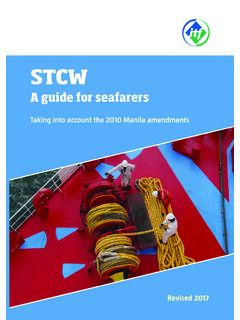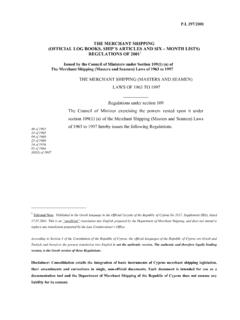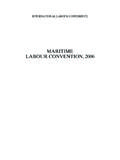Transcription of Approved Doctor’s Manual - GOV.UK
1 Approved Doctor s Manual Seafarer Medical Examinations July 2020 This Manual is intended to be read in conjunction with MSN 1886 (M+F) Medical Fitness Standards 1 Contents Chapter 1: Health of Introduction Legal requirements for medical Purpose of the seafarer health Maritime working Treatment and welfare onboard Medical stores and the Doctor s Training of seafarers in first aid and medical Radio medical advice Occupational health and safety for Special hospital care in the Expenses of medical and other treatment during a voyage ForewordInstructions for useChapter 2: Procedures for appointment of Approved Categories of Approved Training and Document control, records and Quality assurance Quality assurance and audit practical Areas subject to administrative Areas subject to clinical Overseas Approved Outcome: results from Customer Management Relationships with the MCA and Chief Medical Forms re-ordering arrangements Annex A Medical Administration Team (MAT) contact listAnnex B Seafarer Medical Examinations Feedback ReportContents continues on a UK registered shipAnnex A Grandfather rights ILO188 Work in Fishing Convention2 ContentsChapter 3.
2 The medical Relationship with the Relationship with Relationship with professional Ethics and Registration ENG 2 Conducting the Additional Advice on immunisation and Health and vocational Issue of ENG 1 Pa yment of Lost or stolen Return to work Medical reviews ( Appeals ) role of the Medical Referees Specific advice on fitness pending further results Contents continues Standard restrictionsADG 1 Pulmonary TuberculosisADG 2 Infections transmitted in body fluidsADG 3 CancerADG 4 DiabetesADG 5 ObesityADG 6 Mental disordersADG 7 Loss of consciousness, altered awareness, epilepsy and sleep disordersADG 8 Blood pressure and its measurementADG 9 Cardiac eventsADG 10 AsthmaADG 11 Dental inspectionADG 12 Urine testingADG 13 Hearing, ear disease, disorders of speech and communicationADG 14 Vision, eye diseases Annex A Colour vision testing possible outcomes Annex B Visual acuity testing possible outcomesAnnex C Colour Assessment and Diagnosis (CAD) TestADG 15 MedicationADG 16 AllergiesADG 17 Assessment of physical capabilitiesChapter 4.
3 Medical standards and AD guidanceSee Merchant Shipping Notice (MSN 1886) for current medical standards including fitness table3 Chapter 6: Reference Maritime Categorisation of waters (non sea) Sources of help outside Useful publications Useful Merchant Shipping Notices (also previously issued M Notices)Annex A SI that governs appointment of ADsAnnex B MGN 219 ContentsChapter 5: Frequently asked questions (FAQs)Contents4 This Manual is produced to assist Approved doctors with examination procedures, the issue of medical fitness certificates and record keeping. It is therefore written using terms that will be understood by health professionals. Although it may also be a useful source of information for seafarers and others in the maritime sector, this is not its primary purpose.
4 Instructions for useThe Manual can be navigated through interactive links which are highlighted in the contents page and text and through the clearly marked navigational buttons. The interactive decision trees in Chapter 4 are designed to aid decision making by clearly showing each logical step in the process of making diagnoses. If you wish to search for topics in particular the search button at the top of the text pages will open a new window. This window can be enlarged by dragging the right hand side of the box, which will then show more information and help to decide the context of the results returned. If you have any difficulty using the Manual or have any comments to make please contact the Medical Administration Team at Sally BellMCA Chief Medical AdvisorForewordThis Manual details the procedures to be followed to ensure that medical assessments for seafarers serving on UK ships are carried out to the standards required by the Maritime and Coastguard Agency in terms of compliance with statutory requirements, good medical practice and Manual includes detailed guidance on individual medical conditions for MCA Approved doctors (ADs).
5 These ar e linked to the medical fitness standards in Merchant Sh ipping Notice 1886 which must always be used as your first reference point. This guidance also includes a series of frameworks for structured decision-taking to aid consistency in fitness certification. A standard format has been used and guidance has been prepared for seventeen conditions that are common and which have previously led to questions about the correct issue of fitness have replaced MSN 1839(M), which currently includes both the medical fitness standards and guidance on the medical examination procedure, with: MSN 1886(M+F) which contains the medical standards applicable toboth seafarers and fishermen; it also contains the statutory informationApproved doctors need to be aware of. MSN 1887 (M) which contains information for shipping companies etc,and seafarers on the statutory processes and guidance around seafarermedical examinations; MSN 1883 (F) which contains information for fishing vessel owners,managers etc and fishermen on the statutory processes and guidancearound medical examinations for previous next Chapter It is universally accepted that seafaring is a potentially hazardous occupation which calls for a high standard of health and fitness for all those working in the industry.
6 Regulations place a duty on seafarers on board UK ships to take care of their health and safety and to co-operate with their Ships require a range of expertise at all crew levels and the use of new technology to maximise efficiency is becoming more commonplace. However, despite the development of modern technology it will never replace the most valuable resource on a ship: the crew. The requirement that seafarers must be fully fit to carry out the full range of their duties remains as important today as it did when scurvy took its toll on the first oceanic The assessment of medical aspects of fitness is only one part of the arrangements for seafarers health. Living and working conditions need to be safe and free of health risk, care is needed for injury and illness at sea, and access to onshore health care facilities is of Legal requirements for medical Purpose of the seafarer health Maritime working Treatment and welfare onboard Medical stores and the Doctor s Training of seafarers in first aid and medical Radio medical Occupational health and safety for Special hospital care in the Expenses of medical and other treatment during a voyage on a UK registered shipReturn to contentsSearchPrint allPrint this section6 previous next Return to contentsSearchPrint allPrint this sectionChapter 1.
7 Health of Legal requirements for medical examinationMedical The Merchant Shipping (Medical Certification) Regulations (referred to in this Manual as the Regulations ) in force from 6 April 2010, make it a legal requirement for any seafarer (defined as any person, including the master, who is employed or engaged or works in any capacity aboard a ship and whose normal place of work is on a ship) to hold a valid medical certificate attesting to their medical fitness to perform their MSN 1886 (M+F) which describes the Seafarer Medical Examination System and Medical and Eyesight Standards, contains the detailed mandatory requirements specified by the Secretary of State under the Regulations, and gives guidance on the application and provisions of the regulations. It is essential that these standards are followed in all Although some seafarers have relatively long periods at home between periods of sea service, others will need to arrange a medical examination during a short port call, and Approved doctors (ADs) should, where possible, be reasonably flexible to accommodate such When a ship is in a foreign port, Port State Control inspections may be carried out, and the medical fitness certification of the crew is one area that may be checked.
8 It is therefore important that certificates are correctly relevant All officers and ratings serving on UK flagged merchant vessels must hold relevant Certificates of Competency and the International convention on Standards of Training, Certification and Watchkeeping for Seafarers 1978, as amended , ( stcw 78) and its associated Code ( stcw Code) sets the standards which govern the awards of these certificates and controls watchkeeping arrangements. In the United Kingdom, the Merchant Shipping (Training and Certification) Regulations 1997 implement some of the requirements of stcw stcw 78 prescribes the mandatory requirements for certification of deck and engineer officers and watch ratings including requirements relating to age, medical fitness, seagoing service and standards of competence.
9 To satisfy these, candidates for UK Certificates of Competency have to meet certain medical standards (including eyesight); satisfactorily complete a minimum period of seagoing service; reach the required vocational and academic standard; undertake ancillary technical training, and in the case of officer candidates, on completion of programmes of education and training Approved by the Maritime and Coastguard Agency (MCA), pass an oral examination conducted by an MCA There are equivalent national provisions, including medical fitness requirements, for those taking charge of vessels falling outside the scope of the stcw previous next Return to contentsSearchPrint allPrint this sectionChapter 1: Health of Purpose of the seafarer medical The fundamental purpose of the seafarer medical assessment (a)fitness to navigate a ship safely(b)fitness in both physical and psychological terms to dealwith emergencies at sea(c)freedom from foreseeable risk of disease while at sea,especially where this might either spread to others onboard, require emergency treatment or lead to evacuationor diversion(d)recognition that seafaring careers can be terminatedprematurely by conditions which can be prevented, suchas ischaemic vascular disease and lung cancer(e)absence of discrimination based on disability or medicalcondition, except where this can be justified byrequirements (a) to (c)
10 Maritime working The occupational circumstances which apply at sea should be fully considered when a decision on a seafarer s medical fitness is taken. Particular factors to take into account are: the potentially hazardous nature of seafaring, which calls for a high standard of health and continuing fitness; the restricted medical facilities likely to be available on board ship (few ships carry doctors and first aid training for crews is limited); the likelihood of limited medical supplies and delay before full medical treatment is available; the possible difficulty of providing/replacing required medication; as a general rule a seafarer should not be is to ensure that the individual seafarer is fit for the work for which he or she is to be employed, taking into account the particular risks associated with working at sea.










